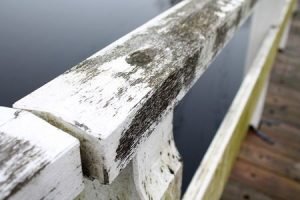Removal of paint or varnish from various surfaces is usually difficult and complicated task. Which method to choose? One of the solutions may be the increasingly popular laser removal of coatings (laser ablation) or sandblasting. You can also use mechanical removal with wire brushes or sandpaper.

However, the above methods can be expensive and risky, especially due to the possibility of damage to the surface being cleaned (wood, plastics, plasters). In addition, an improperly chosen method of removing the coating may expose the surface to unfavourable weather conditions. An example of this is the damage to the walls and plasters of external walls, which can lead to the building structure becoming damp, thus reducing its mechanical strength. It turns out, however, that an effective and cheap alternative to mechanical removal of paints and coatings from the surface is popular caustic soda. The use of soda lye (caustic soda solution) reduces the risk of surface damage that may occur using other methods.
Caustic soda is a white substance with a crystalline structure. It dissolves very well in water, creating a highly corrosive solution (soda lye), accompanied by the release of large amounts of heat. Sodium hydroxide dissolved in water is an odourless and non-flammable liquid that has a corrosive effect on metals. In addition, soda lye reacts readily with metals with amphoteric properties, which releases hydrogen. During contact with this substance, special care should be taken because in the form of dust or vapor as it causes pain and watery eyes, burning sensation in the nose and throat, and coughing. In contact with skin, sodium hydroxide causes chemical burns with potential blisters and necrosis. It is particularly dangerous to get this substance into the digestive tract. It causes burns of the mucous membrane and, in extreme cases, perforation of the esophageal walls, which may lead to internal bleeding and, consequently, death. Therefore, when handling sodium hydroxide, be very careful and use appropriate personal protective equipment, such as goggles and protective masks, latex gloves, protective clothing and footwear. It is also necessary to ensure adequate ventilation of the rooms.
The most popular preparation used to remove paint is a 10% aqueous solution of sodium hydroxide. To prepare, an appropriate amount of caustic soda is measured and gradually and carefully added to the previously prepared water, stirring the contents of the vessel until dissolved. For storage of such a solution, containers made of plastic or glass are best suited. The 10% NaOH solution prepared in this way is applied to the surface to remove paint. It decomposes chemical bonds of the coating, usually due to the hydrolysis reaction of the polymer chains. Prior heating of the solution significantly accelerates the process of removing old paint coatings, which is much safer in the case of getting rid of varnish from wooden elements.
Now we come to the key question. From which surfaces can we remove old coatings with sodium hydroxide?
The first group are metals. Soda lye effectively removes varnish coatings from various types of gates, fireplaces or decorative objects made of metals. However, it must be born in mind that it is not able to remove rust. In the case of removing coatings from wood, the key aspect is its type. There are usually no problems with wood from trees such as pine (used mainly for the production of doors, chairs, skirting boards, armbands, chests of drawers and cupboards), beech (mainly chairs) or exotic sanshō. It is enough to apply diluted soda lye to the surface of the wood, then rinse thoroughly with water. It can be difficult in the case of pine species called “pitch pine”. When removing the old coating, this type of wood becomes fibrous, which makes it difficult to prepare it for re-painting. In turn, wood derived from elm, oak and walnut after removing the old paint coating tends to change colour to a slightly darker shade.
Soda lye is definitely not recommended for use on plywood and veneer. After removal of the varnish, the layers usually come apart. The last group of surfaces to which the chemical method of removing coatings can be applied are plastics. Aqueous solution of caustic soda also works well here – used in a careful way, it does not cause damage to polymer chains of most commonly used plastics.
Of course, there is also a group of coatings, which caustic soda is unable to remove. These include, for example, modern water based primers and acrylic paints. The same applies to all oven enamels and powder paints. In order to remove these types of varnish coatings, specialized chemicals are usually used, which are applied evenly on a given coating. After applying, you have to wait for a longer time and then scrape the old paint with a putty knife or scraper. In turn, the aluminium alloys start to tarnish and dissolve as a result of the reaction with the caustic soda solution. The same effect is observed in the case of mirrors, which simply break after contact with sodium hydroxide. Soda lye should not be used in the removal of coatings from particleboard and fibreboards. These materials are irreversibly broken in contact with this substance.